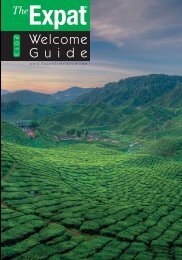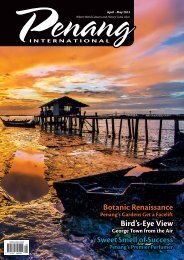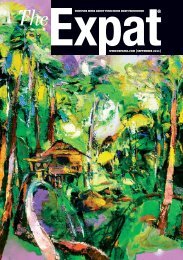Celebrate Heritage! Hidden Retreat The Road ... - The Expat Group
Celebrate Heritage! Hidden Retreat The Road ... - The Expat Group
Celebrate Heritage! Hidden Retreat The Road ... - The Expat Group
Create successful ePaper yourself
Turn your PDF publications into a flip-book with our unique Google optimized e-Paper software.
and European porte cochéres. <strong>The</strong>se “Penang<br />
bungalows” can be found all around the<br />
island today.<br />
Lucky Locations<br />
While the Europeans and Jawi Peranakans<br />
gravitated towards the bungalow form, the<br />
Baba Nyonya families, made up of a Chinese<br />
trader with a local wife, preferred to reside<br />
right in the heart of the business district, as<br />
traders often considered the location where<br />
they first got their “big break” to be lucky.<br />
<strong>The</strong> Baba Nyonya residential shop houses<br />
and dwelling houses are a form all their<br />
own, celebrated throughout Penang and<br />
the region. Whether business or residential,<br />
each shop house shares a few common<br />
characteristics: Each includes an intricately<br />
decorated air vent, commonly featuring the<br />
image of a peony (symbolizing wealth) and<br />
the bat (symbolizing good fortune).<br />
<strong>The</strong>ir façades reflect the time in which they<br />
were made, with simple single-shuttered<br />
second-storey windows representing the<br />
early South Chinese style, while the more<br />
intricately designed triple-arched and<br />
shuttered second-storey windows represent<br />
the later Straits Eclectic phase.<br />
And, of course, there are those wonderful<br />
five-foot walkways. First implemented<br />
in 1826, these public walkways were<br />
soon paved with intricate tiles, which<br />
protected both the walk and the building’s<br />
façade from water damage. <strong>The</strong> buildings<br />
themselves originally took to the Malay<br />
timber and atap materials, but after a series<br />
of fires, they were soon<br />
replaced with brick.<br />
<strong>The</strong> Chinese residential shop<br />
house provides a perfect<br />
balance between function<br />
and symbolism. Designed<br />
to utilize every bit of space,<br />
each dwelling house has the<br />
same basic features: a Chinese<br />
screen a few feet back from the doorway to<br />
hold back bad energy, a courtyard providing<br />
ventilation and natural sunlight, a Chinese<br />
altar, and intricately designed doors, often<br />
featuring images of vases (peace and<br />
tranquility) and peaches (longevity). By<br />
the early 20th century, the Straits Chinese<br />
house became popularised. As wealth began<br />
to rise, it was not uncommon to see an<br />
ornately furnished dwelling house set up<br />
against a slum.<br />
Splendid Structures<br />
Perhaps the most materially ornate<br />
houses in Penang, as well as the most<br />
culturally diverse, are the mansions of<br />
Southeast Asia’s richest men. Penang’s<br />
famous green Peranakan Mansion, a<br />
townhouse once owned by Chung Keng<br />
Kooi, the Kapitan China of Perak, features<br />
Cantonese glassworks, Scottish iron gates,<br />
European floors, and a vaguely Venetian<br />
exterior. <strong>The</strong> Blue Mansion, the foremost<br />
capitalist Cheong Fatt Tze’s most grand<br />
abode, features art nouveau stained glass<br />
windows, Victorian floor tiles, and timber<br />
wall decorations.<br />
Largely built according to the principles of<br />
Feng Shui, the Straits Chinese houses promote<br />
a sense of calm and wellbeing, or good chi,<br />
yet remain incredibly extravagant in design,<br />
signalling to any visitor that no material<br />
possession was out of reach.<br />
Even the places of worship in George Town<br />
come from a diverse blend of traditions.<br />
Penang’s St. George’s Church was built in<br />
the European neoclassical tradition. <strong>The</strong><br />
Kapitan Keling Mosque was built in the<br />
north Indian Moghul style. <strong>The</strong> Acheen<br />
Street mosque marries the colonial, Indian,<br />
and Malay style together, and the Sri<br />
Mariamman temple represents the classical<br />
Dravidian architecture of South India.<br />
<strong>The</strong> sheer amount of depth to the<br />
architecture found on Penang could make<br />
any enthusiast swoon with delight. <strong>The</strong><br />
buildings’ wonderfully diverse designs<br />
make Penang a visual delight enjoyed by<br />
locals, expats, and tourists alike. Like every<br />
cultural element of this intriguing island,<br />
from its food to its local dialect, the city’s<br />
architecture tells a rich historical tale of the<br />
intermingling of traditions, and the fusion<br />
of two worlds into one.<br />
<strong>Heritage</strong> Houses of Penang by Khoo Salma<br />
Nasution and Halim Berbar provided much of the<br />
material found in this article. I highly recommend this<br />
book to anyone interested in the architectural heritage<br />
of Penang.<br />
Penang International 21







